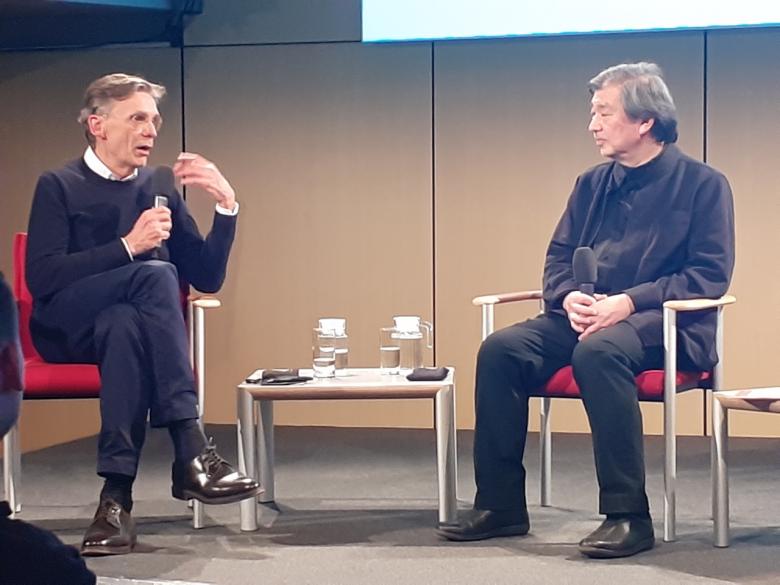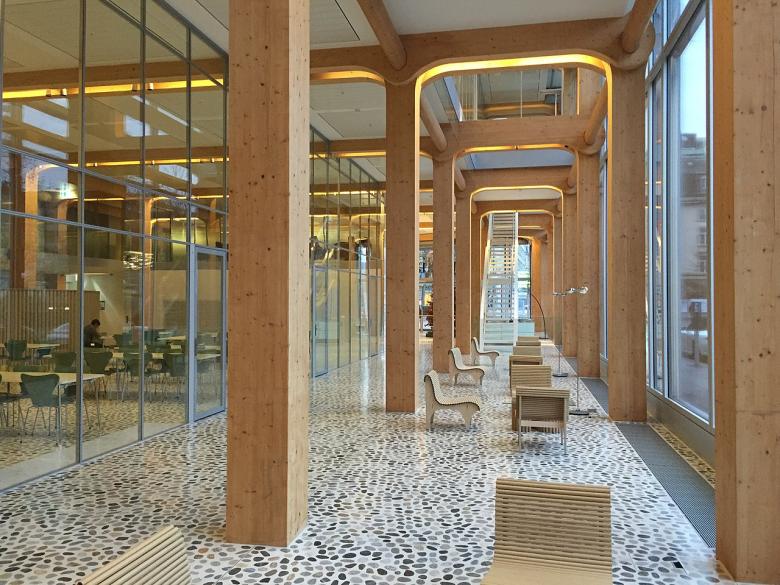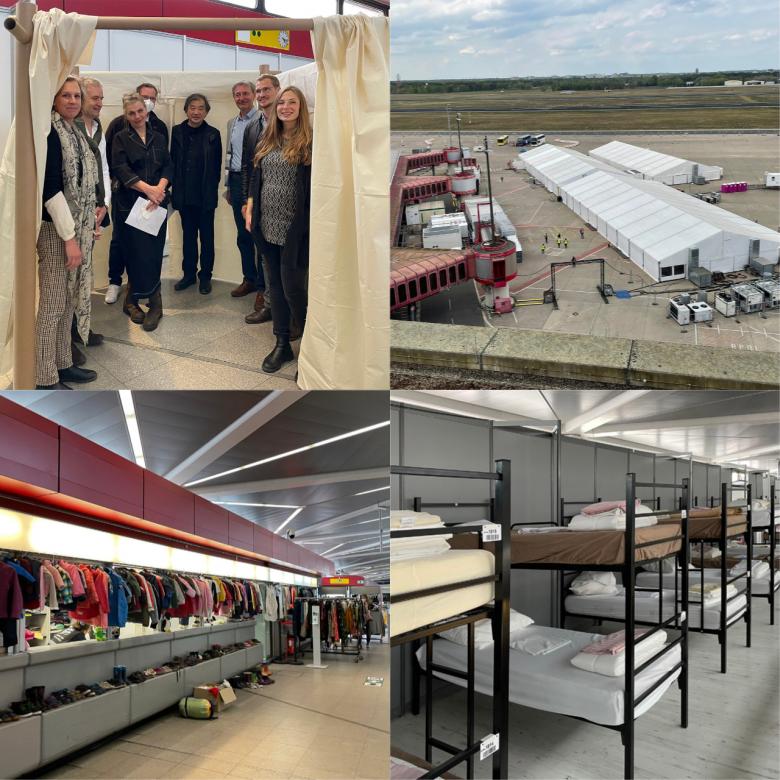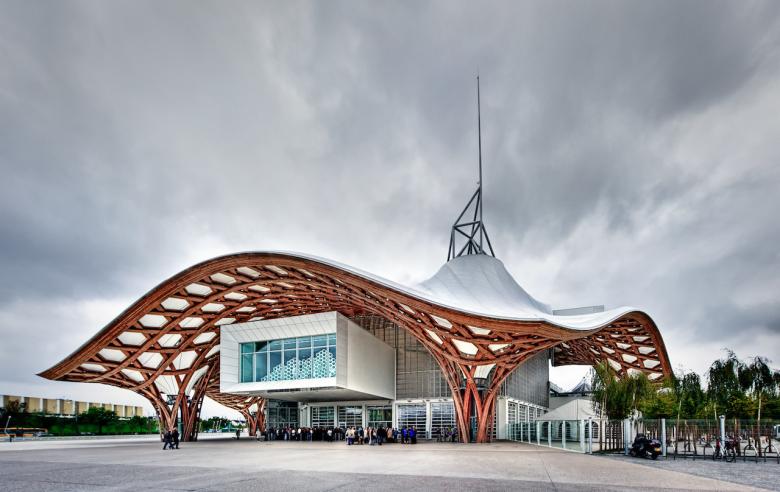Form Finding, Not Form Making
Ulf Meyer
23. 5月 2022
Shigeru Ban (right) in conversation with Matthias Sauerbruch at the Akademie der Künste on May 4, 2022. (Photo: Ulf Meyer)
Earlier this month Shigeru Ban spoke at the Akademie der Künste in Berlin as part of the "On the Duty and the Power of Architecture" lecture series. Ulf Meyer sat down with the Japanese architect after the talk, when he spoke about the cardboard-tube system used for Ukrainian refugees and explained how his various commissions relate to each other.
Ulf Meyer: Every day thousands of Ukrainians flee to the West and many arrive in Berlin by train. You are in town to promote your cardboard-tube system to build booths for refugees who have to stay in gyms and halls.
Shigeru Ban: Privacy is the most important basic human right, even for people staying just one night. Without privacy they cannot relax or sleep well. People who had to leave their country are very tired. I have done this in different situations — for flooding, tsunami or earthquake victims who have to stay for four months in temporary shelters before their houses are rebuilt.
Your system provides visual privacy, but not acoustic privacy.
If acoustic privacy is needed, we separate the booths with a distance. The setup depends on the density of the facility. Our system is flexible; units can be combined for families of different sizes.
With the Voluntary Architects Network (VAN) that you have set up, there seems to be a continuity from one crisis to another.
A positive thing is that when a disaster happens anywhere in the world, I just send an email to a local architecture professor and because my work is known around the world, I can find a local partner easily. There are young students and architects who are looking for social work. When I started this in the 80s nobody was interested in it. But I no longer use the word “sustainability.” It is too commercial now, everybody uses it without thinking about its definition. I started using it in 1987, but I was not part of the fashionable movement. Thinking about the environment is very important, though, and I just don’t like to waste material. We cannot tell which material is better. Steel or concrete can be good. Even a concrete building can be destroyed by developers, who want to build a new building. Some of my paper buildings have become more permanent.
Tamedia Office Building, Zurich, 2013 (Photo: Melissanews/Wikimedia Commons)
Your new office building in Nagoya, the Tamadic Building, is innovative, because it uses CLT forms into which concrete is poured for the columns. Japanese code is not friendly to the use of wood as a structural material for urban buildings.
I made the Tamedia and Swatch buildings in Switzerland in timber, but I could not do that in Japan. I combine the tubular effect of CLT for bending and lateral forces. The wooden formwork remains in place. It is the final finish, so it looks like a wooden building.
The Mokuzai-Kaikan building in Tokyo Shin-Kiba, designed by Yamanashi of Nikken Sekkei, tries to push the legal boundaries for fire safety in Japan. He uses some tricks such as smoke-free engawas around the building and ceiling coffers that could absorb smoke in case of fire. Do you follow the same thinking?
I share the same goal but I do it differently. Now it is popular to use CLT for tall buildings, but it often cannot be exposed. But if the wood cannot be visible, we cannot take advantage of it. I do not use tricks, just new ways. Normally you make concrete with plywood, but when you keep it, you need less time for construction and do not need to throw away the plywood.
For the Expo Pavilion in Hannover, you also had problems with the building code…
No, it was not the regulation, just the prejudice of the people. I started working with Frei Otto three years prior to the Expo and we had a very good test engineer. Our design was almost approved. But later the test engineer was exchanged. It is not about regulation, but prejudice. That makes new developments difficult. Every country has its own regulations and you have to respect that.
France and Switzerland are very receptive to Japanese architects, but Germany is not.
I was asked to change my design, but I did not agree. Maybe I should have called it a “hybrid building.” Architects should keep challenging.
Today I went to the former Tegel Airport to demonstrate my partition system for privacy. Now they rent an expensive system used for trade fairs. We suggest using cardboard tubes. Even at the Expo, without any treatment of the cardboard tubes we got a “B1” fie proofing rating.
The Voluntary Architects' Network at the former Tegel Airport on May 4 demonstrating their Ukrainian refugee facility. (Photo: VAN/Facebook)
For the Zazen Dojo on Awaji Island in Japan you use a Vierendeel truss made of wood for the cantilever, which is rather unusual. Do you develop new details and structural ideas in your Japanese domestic projects that “trickle down” into your social projects?
The main challenge was not the Vierendeel but the roof structure made of timber. Usually, I need a thick beam to make a joist, but here I removed it. It is hidden and not expressed. It does not look like a high-tech solution.
Now that Frei Otto is dead, do you have another favorite engineer to work with?
He was an architect! I had to prove that so he could get the Pritzker Prize. I was so lucky to be able to work with him closely on the Hannover project because we shared the same idea: to design a building with the lightest materials. It was a great way for me to develop myself. Now people make unusual shapes, but that is form making, not form finding. That is a totally different approach.
Who would be your partner now to talk about structural new ideas?
My wood projects are made in collaboration with Hermann Blumer. We share the same ideas. Before I met him, another company was hired to execute my projects, but they thought it would be over budget; he proved that it was possible.
Do you see the Pompidou Center in Metz as a prelude to the Swatch Building in Biel/Bienne?
Yes, the German and Swiss engineers are the best for wooden structures.
Austria would claim to be in the top three as well.
Yes, Japan is quite far behind. There is no great manufacturing for wooden structures and the code is really terrible.
Centre Pompidou-Metz, 2010 (Photo: Kay Gaensler/Flickr)
Surprisingly, there is very little forestry business in Japan, all wood is imported.
It is for commercial reasons that buildings get knocked down, it has nothing to do with durability. After every earthquake we have new regulations and all new buildings have to meet the new regulations. When you renovate a building, you have to meet the new standards, so many buildings get knocked down.
Osaka will host the next World Exposition in 2025. We design the pavilion for ZERI Japan, the partner of the Zero-Emissions Foundation from Switzerland. We do not use piles; the pavilion is made of carbon fiber, which is very light and does not require a pile foundation. The site for the Expo is a manmade island and even temporary buildings need major piling, which I think is wrong. Normally carbon fiber is expensive and only used for cars of aircraft. Our foundation is flat and we make three spheres. One is made of bamboo, but not tubular bamboo; we use laminated bamboo.
You have stressed how flexibility affects durability of a building. In the Naked House, for example, the box-like rooms can be moved around and into the garden.
That was a requirement by the client.
Let’s compare it to your Shishi-iwa in Karuizawa in Nagano Prefecture. There, rooms are neutral. Japan does not traditionally have separate living rooms, dining rooms, and bedrooms, but the rooms are used for different purposes during different times of the day.
That hotel is quite economical, and the rooms are quite small. If I made a separation between room and bath, it would have gotten too small. So I put the wooden traditional bath tub right into the guest rooms. Otherwise, things would have become too tight. It is multi-functional.
Thank you very much.



